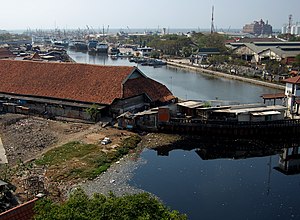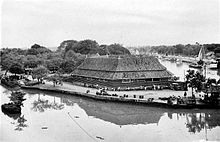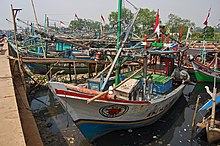Penjaringan: Difference between revisions
Rochelimit (talk | contribs) mNo edit summary |
Rochelimit (talk | contribs) |
||
| Line 24: | Line 24: | ||
==Flooding== |
==Flooding== |
||
Being a low plain coastal area, Penjaringan is constantly threatened by flooding from high tide. In Penjaringan Administrative Village itself, a series of plan to reduce flooding has been planned, including settlement relocation, drainage improvement, and the construction of [[dike]].<ref>http://bebasbanjir2025.wordpress.com/konsep-pemerintah/klh/</ref> Research about flooding has been done especially within Penjaringan Subdistrict.<ref>http://www.indie-indonesie.nl/content/documents/papers-urban%20history/caljouw%20nas%20pratiwo.pdf</ref> |
Being a low plain coastal area, Penjaringan is constantly threatened by flooding from high tide. In Penjaringan Administrative Village itself, a series of plan to reduce flooding has been planned, including settlement relocation, drainage improvement, and the construction of [[dike]].<ref>http://bebasbanjir2025.wordpress.com/konsep-pemerintah/klh/</ref> Research about flooding has been done especially within Penjaringan Subdistrict.<ref>http://www.indie-indonesie.nl/content/documents/papers-urban%20history/caljouw%20nas%20pratiwo.pdf</ref> |
||
In 2008, seven dikes are installed within Subdistrict of Penjaringan to protect the area from increasing level of sea tide. The dike consists of Muara Baru dike, Muara Angke dike, Luar Batang dike, Pluit Reservoir, Kapuk Muara dike, Pelindo Harbor dike, and Mutiara Beach dike.<ref>http://www.beritajakarta.com/english/NewsView.asp?ID=9000</ref> |
|||
==Kelurahan (Administrative Village)== |
==Kelurahan (Administrative Village)== |
||
Revision as of 02:38, 25 March 2010

Penjaringan is a subdistrict of North Jakarta, Jakarta, Indonesia. It is the westernmost Subdistrict of North Jakarta. Muara Angke Port and the mouth of Sunda Kelapa Port is located within Penjaringan. Penjaringan contains the remnants of the original mangrove forest of Jakarta, some is protected by the government (i.e. Muara Angke Wildlife Sanctuary). Penjaringan Subdistrict is crisscrossed with water draining channels, canals, and water reservoirs to protect the land from sea flooding. The Cengkareng Drain, part of Jakarta's flood control system, flows to the sea through this subdistrict.
The area of Penjaringan Subdistrict, especially within Penjaringan Administrative Village, contains several historic Dutch colonial buildings such as the remains of city wall of Batavia and the 17th century warehouses (now a Maritime Museum).
The boundaries of Penjaringan Subdistrict are Jakarta Bay to the north, Sunda Kelapa port to the east, and Kamal Muara road - Kapuk Raya road to the south.
History
The coastal area of Penjaringan Subdistrict is one of the historic area of Jakarta, being located at the mouth of Ciliwung River which is an important port area in West Java, being used as the main port of the kingdom of Pakuan Pajajaran and Batavia. The area has been a location of wars between local kingdoms, the Portuguese Empire and the Dutch Indies. Around 16th century, the area of Muara Angke (coastal area of Penjaringan, just to the west of old Batavia) was considered a strategic area by the Sultanate of Banten and the Sultanate of Demak to seize the port of Sunda Kelapa from the Portuguese.

During the Dutch colonial era, the area that is now Penjaringan Administrative Village was developed into a ship docking area. Warehouses are built on this area since the 17th century, some of these buildings still exist today (such as the now Museum Bahari and Galangan Kapal VOC, a former trade office built in 1628). This port of Batavia was once part of a major port of the spice trade commercial network in Asia.
Several villages appear during the Dutch colonial era. Some of this village, located within the port of Batavia, is today known as Kampung Luar Batang. This village is the location of the Luar Batang Mosque, built in 1739.
During the 1970s, because of insufficient capacity and the lack of facility, a new fishing port called Pelabuhan Perikanan Samudera Jakarta (PPSJ) (also known as "Jakarta Fishing Port") was created on the west side of Sunda Kelapa Harbor, within Penjaringan Subdistrict. The feasibility and enginnering study was done by Japan International Cooperation Agency from 1973 to 1979. The construction was divided into four phases which began in 1980 and was finished in 2002.[1]
Mangrove forest

Penjaringan contains some of Jakarta's original mangrove forest. Some of this mangrove forests are protected as the Muara Angke Wildlife Sanctuary (located at Kapuk Muara Administrative Village). Muara Angke Wildlife Sanctuary was protected since the governency of the Dutch Indies on June 17, 1939, covering an area of 15.04 ha. During the 1960s, the conservation area was expanded to 1,344.62 ha. Later, because of human pressure and environmental destruction within and around the national park, some of the mangrove forest area were destroyed. On February 28, 1988, the area was declared a Nature Reserve (25.4 ha).[2] On November 1998, the status of this area changed to Wildlife Sanctuary or Suaka Margasatwa (25.02 ha).[3] Muara Angke Wildlife Sanctuary is listed as one of the important bird sanctuary in Java, protecting bird species such as milky stork and the endemic sunda coucal.[4] Muara Angke Wildlife Sanctuary is currently facing issues such as mangrove cutting, water pollution (especially in Angke River), and settlements development at the edge of the area.[5]
Other protected mangrove forest of Penjaringan Subdistrict is the privately owned[6] Taman Wisata Alam Angke Kapuk (99.82 ha).[7] The Taman Wisata Alam Angke Kapuk is also developed as ecological resorts and bird watching facilities.[8]
Flooding
Being a low plain coastal area, Penjaringan is constantly threatened by flooding from high tide. In Penjaringan Administrative Village itself, a series of plan to reduce flooding has been planned, including settlement relocation, drainage improvement, and the construction of dike.[9] Research about flooding has been done especially within Penjaringan Subdistrict.[10]
In 2008, seven dikes are installed within Subdistrict of Penjaringan to protect the area from increasing level of sea tide. The dike consists of Muara Baru dike, Muara Angke dike, Luar Batang dike, Pluit Reservoir, Kapuk Muara dike, Pelindo Harbor dike, and Mutiara Beach dike.[11]
Kelurahan (Administrative Village)
The subdistrict of Penjaringan is divided into five kelurahan ("administrative villages"):
- Penjaringan - area code 14440
- Pluit - area code 14450
- Pejagalan - area code 14450
- Kapuk Muara - area code 14460
- Kamal Muara - area code 14470
List of important places

- Galangan Kapal VOC
- Jakarta Fishing Port
- Luar Batang Mosque (established since 1796)[12]
- Luar Batang Village, existed since the 17th century.
- Maritime Museum (Indonesia)
- Muara Angke Wildlife Sanctuary
- Muara Angke Port
- Pantai Mutiara
- Pasar Ikan ("Fish Market")
- Pluit water reservoir
- Raja Ikan Restaurant
References
- ^ "History - Pelabuhan Perikanan Samudera Jakarta". Jakarta Fish Port. PACIFIC CONSULTANTS INTERNATIONAL. Retrieved March 24, 2010.
- ^ SK Menteri Kehutanan No. 095/Kpts-II/88 on 28 February 1988 (Anon 1997)
- ^ SK Menteri Kehutanan dan Perkebunan No 097/Kpts-II/1998
- ^ "Muara Angke". BirdLife International. BirdLife International. Retrieved March 24, 2010.
- ^ MacKinnon et.al. 1982
- ^ Jakarta's government has given the area to PT Murindra Karya Lestari in attempt to rehabilitate the area back into its original natural state.
- ^ Gunawan (October 12, 2006). "Taman Wisata Alam Angke Kapuk". Wisata Pesisir. Wisata Pesisir. Retrieved March 24, 2010.
- ^ Louise (March 17, 2010). "Wisata Alam Di Ujung Kota Jakarta". Wisata Pesisir. Wisata Pesisir. Retrieved March 24, 2010.
- ^ http://bebasbanjir2025.wordpress.com/konsep-pemerintah/klh/
- ^ http://www.indie-indonesie.nl/content/documents/papers-urban%20history/caljouw%20nas%20pratiwo.pdf
- ^ http://www.beritajakarta.com/english/NewsView.asp?ID=9000
- ^ http://www.wisatapesisir.com/id/kampung-luar-batang/126-masjid-luar-batang-berdiri-sejak-17-masehi
